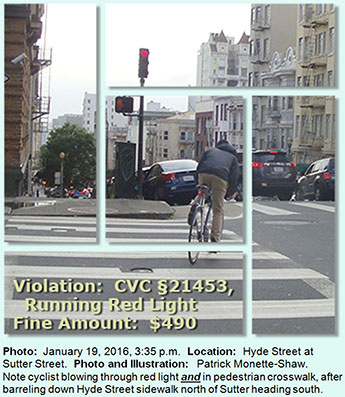 Westside
Observer Newspaper
Westside
Observer NewspaperFebruary 2016 at www.WestsideObserver.com
Protecting Pedestrians From Scofflaw Bicyclists
Pedestrian Safety Not “Worthwhile”?
Article in Press Printer-friendly PDF file
 Westside
Observer Newspaper
Westside
Observer Newspaper
February 2016 at www.WestsideObserver.com
Protecting
Pedestrians From Scofflaw Bicyclists
Pedestrian
Safety Not “Worthwhile”?
by Patrick Monette-Shaw
Just as truth typically becomes the first casualty of war, in the on-going war to enhance San Francisco’s pedestrian safety, the truth about pedestrian accidents caused by bicyclists appears to be a veracity casualty of San Francisco Police Department statistics.
The San Francisco Chronicle reported December 14 millennial bicyclist Katrina Sostek felt her $200 fine for running a stop sign at Duboce Avenue and Church Street was unfair. The police officer who ticketed her “could have been doing something worthwhile,” Sostek whined. Puh-leeze, Katrina! Don’t want a traffic ticket? Then simply obey State law and come to a full stop.
When did protecting my life from rogue bicyclists become unworthwhile? How did preventing bicyclists from receiving mere traffic violation citations become more “worthwhile” than protecting pedestrians like me?
Running stop signs is dangerous behavior that might cost me my life. From my perch, traffic law enforcement to protect me is completely worthwhile, despite Sostek’s misguided wail.
Not to be outdone, Board of Supervisors’ president London Breed was quoted in the same Chronicle article saying “Our limited police resources should be used for more important things” involving public safety. Golly, Supervisor Breed! When did tr affic law enforcement to protect my life become both unworthwhile and less important?
 The squeaky-wheel
— the San Francisco Bicycle Coalition itself — posted
a notice on its web site on December 18, saying
(among other things):
The squeaky-wheel
— the San Francisco Bicycle Coalition itself — posted
a notice on its web site on December 18, saying
(among other things):
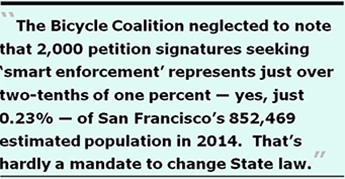 Meanwhile, at one
of the most dangerous intersections in the country — Market
and Octavia — the San Francisco Police Department (SFPD)
invested zero officer-hours in traffic enforcement over a four-week
period that included the crackdown.
Meanwhile, at one
of the most dangerous intersections in the country — Market
and Octavia — the San Francisco Police Department (SFPD)
invested zero officer-hours in traffic enforcement over a four-week
period that included the crackdown.Tellingly, the Bicycle Coalition neglected to note that 2,000 petition signatures seeking “smart enforcement” represents just over two-tenths of one percent — yes, just 0.23% — of San Francisco’s 852,469 estimated population in 2014. That’s hardly a mandate to change State law. In my book, “smart enforcement” suggests that when laws are enforced, they’ll be obeyed.
The Bike Coalition appears to want an exemption just for them so they don’t have to obey the law like everyone else. Handing them an exemption to State law is actually what may be counter-productive to reducing morbidity and mortality.
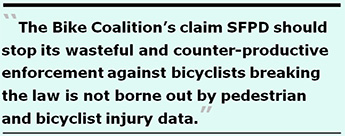 The Bike Coalition’s
claim SFPD should stop its wasteful and counter-productive enforcement
against bicyclists breaking the law is not borne out by pedestrian
and bicyclist injury data (see below). Market and Octavia may
be a dangerous intersection, but it is not
one of the top-five most dangerous intersections in San Francisco.
And the Bike Coalition also neglected noting that at least five
of the 11 City departments that adopted statements supporting
Vision Zero now oppose the rolling-stop bike law, including the
Department of Public Health, SFMTA, the Police Department, the
Mayor’s Office, and the Mayor’s Disability Council.
The Bike Coalition’s
claim SFPD should stop its wasteful and counter-productive enforcement
against bicyclists breaking the law is not borne out by pedestrian
and bicyclist injury data (see below). Market and Octavia may
be a dangerous intersection, but it is not
one of the top-five most dangerous intersections in San Francisco.
And the Bike Coalition also neglected noting that at least five
of the 11 City departments that adopted statements supporting
Vision Zero now oppose the rolling-stop bike law, including the
Department of Public Health, SFMTA, the Police Department, the
Mayor’s Office, and the Mayor’s Disability Council.
Encouraging Illegal Behavior
Police Chief Greg Suhr also disagrees. Suhr wrote to the Board of Supervisors’ Land Use and Public Safety Committee on December 4 saying the proposed “rolling stop” bicyclist legislation would encourage illegal behavior by those using one specific mode of transportation [bicycles] to violate California Vehicle Code §22450(a) — prohibiting running stop signs — putting others at risk of injuries, ranging from minor to fatal.
 San Francisco’s
Vision Zero plan purports it will assist in reducing traffic fatalities
by employing a “Focus on the Five” strategy to enforce
the top five collision factors — running stop signs (CVC
§22450(a)), running red lights (CVC §21453), violating
pedestrian right-of-way (CVC §21950(a)), committing turning
violations (CVC §21801), and speeding (CVC §22350).
These are all moving violations subject to Police Department enforcement,
not SFMTA Parking Control Officer enforcement issues.
San Francisco’s
Vision Zero plan purports it will assist in reducing traffic fatalities
by employing a “Focus on the Five” strategy to enforce
the top five collision factors — running stop signs (CVC
§22450(a)), running red lights (CVC §21453), violating
pedestrian right-of-way (CVC §21950(a)), committing turning
violations (CVC §21801), and speeding (CVC §22350).
These are all moving violations subject to Police Department enforcement,
not SFMTA Parking Control Officer enforcement issues.
Unfortunately, Suhr suggested the commitment is to focus this strategy on these five factors only in the City’s top five most dangerous intersections. The current five most dangerous intersections are: 1) 16th Street/Potrero Avenue, 2) MLK/Cross Over Drive, 3) Mission Street/6th Street, 4) Van Ness Avenue/Bay Street, and 5) Van Ness Avenue/Broadway Street. [Note: The list is thought to be updated periodically based on shifts in traffic patterns.]
That leaves hundreds or thousands of other intersections throughout the City without any enforcement focus to reduce accidents resulting from the five collision factors. Suhr did qualify that in addition to the top five most dangerous intersections, officers enforce vehicle code violations all over the City.
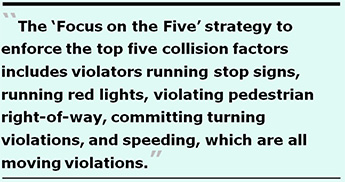 Suhr’s letter
to the Board of Supervisors documented that in the five-year period
between January 1, 2010 and December 31, 2014 bicyclists were
at fault in San Francisco in 30 percent of injury and fatal collisions
— 129 of 427 — due to failure to stop at stop signs,
violating CVC §22450(a). Suhr also claimed that during the
first nine months of 2015 (January 1 through September 30) there
were 447 collisions between bicycles and motor vehicles, including
two bicycle fatalities, with bicyclists at fault in 46 percent
(206) of the incidents.
Suhr’s letter
to the Board of Supervisors documented that in the five-year period
between January 1, 2010 and December 31, 2014 bicyclists were
at fault in San Francisco in 30 percent of injury and fatal collisions
— 129 of 427 — due to failure to stop at stop signs,
violating CVC §22450(a). Suhr also claimed that during the
first nine months of 2015 (January 1 through September 30) there
were 447 collisions between bicycles and motor vehicles, including
two bicycle fatalities, with bicyclists at fault in 46 percent
(206) of the incidents.
It’s odd that Chief Suhr knew bicyclists were at fault 30% of injuries and fatalities due to failure to stop at stop signs, because a public records request (below) shows that SFPD issued just one bicyclist a citation for running a stop sign, and that was in 2015.
Were this SFPD data accurate (it isn’t!), and had just one running-stop-sign citation been issued in the past three years (below), it would illustrate SFPD clearly isn’t doing its job, and would also raise the question of whether the Bicycle Coalition is simply crying “wolf”!
 Comparative
Data
Comparative
Data
Suhr’s statistics mirror a California Highway Patrol analysis of 1,997 accidents showing bicyclists were at fault approximately sixty percent of the time when cyclists were severely injured or sustained fatal injuries.
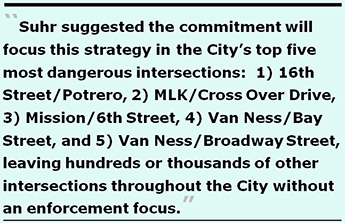 The San Rafael Police
Department reported that between March 2013 and March
2014, bicyclists were at fault in 50 percent of 30 accidents between
cars and bicyclists.
The San Rafael Police
Department reported that between March 2013 and March
2014, bicyclists were at fault in 50 percent of 30 accidents between
cars and bicyclists.
In 2012, the National Highway Traffic Safety Administration (NHTSA) reported 726 cycling-related deaths and 49,000 cycling-related injuries, and that many more injuries go unreported. In 2013, NHTSA reported 4,735 pedestrians were killed and an estimated 66,000 injured in traffic crashes in the United States, but didn’t provide statistics on who was at fault.
NHTSA’s 2012 report noted that more than one-fourth (28 percent) of the cyclists killed in 2012 had blood alcohol concentrations (BACs) of .01% or higher, and almost one-fourth (24 percent) had BACs of .08% or higher.
All states define driving with a blood alcohol concentration (BAC) at or above 0.08% as a crime. With inflated BAC’s, sensory-motor coordination and impaired balance are typical. BAC’s of 0.08% affect reasoning, depth perception, peripheral vision, and glare recovery. BAC’s of 0.100% or higher affect reflexes, reaction time, gross motor control, and staggering.
One dirty little secret is that while everyone knows about the dangers of drunk driving and DUI’s, nobody ever discusses the fact that drunks also climb onto bicycles, and have impaired judgment when it comes to pedestrian safety!
The difference between drunk drivers (DUI’s) and drunk bicyclists (CUI’s — Cyclists Under the Influence) is that for drunk drivers, there is an administrative procedure to suspend driver’s licenses in 42 states on the first drunk-driving offense. Since bicyclists aren’t licensed in California or in San Francisco, there’s no administrative process for making sure CUI’s are taken off our roads!
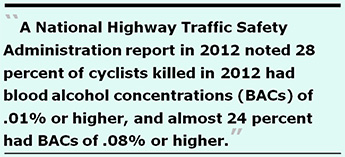 Data initially provided
by SFPD (below) shows that, sadly, police officers issued just
one citation to a cyclist driving “under the influence”
between 2013 and 2015 in violation of CVC §21200.5 —
and that single ticket was issued in 2013. To reflect: Data provided
by SFPD revealed just one citation for riding a bike while drunk
and one other citation for bicyclists running a stop sign during
this three-year period. That’s pathetic enforcement.
Data initially provided
by SFPD (below) shows that, sadly, police officers issued just
one citation to a cyclist driving “under the influence”
between 2013 and 2015 in violation of CVC §21200.5 —
and that single ticket was issued in 2013. To reflect: Data provided
by SFPD revealed just one citation for riding a bike while drunk
and one other citation for bicyclists running a stop sign during
this three-year period. That’s pathetic enforcement.
Megan Hottman, a former professional bike racer, personal-injury lawyer, and co-author of the book Bicycle Accidents: Biomedical, Engineering and Legal Aspects, notes that roughly 47 percent of all bike-car mishaps happen because bicyclists are at fault, a statistic bicycle lobbyists and San Francisco’s Bicycle Coalition probably want to ignore.
Hottman also waded into the discussion of bicyclists driving under the influence, the dirty little secret that the San Francisco Bicycle Coalition — and Supervisor John Avalos, author of San Francisco’s Rolling Stop bike legislation — probably prefer not be mentioned.
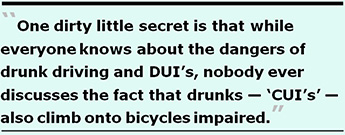 City
Department Records Responses
City
Department Records Responses
Three main records requests were submitted to various City departments for this article — including the Department of Public Health, the Department of Emergency Management, and the San Francisco Police Department — along with several follow-up clarification requests. Records produced revealed disturbing data.
SFGH Trauma Registry Data
The data provided by DPH was solely for San Francisco General Hospital and Trauma Center, which is San Francisco’s single trauma center and, therefore, receives the most severely-injured patients.
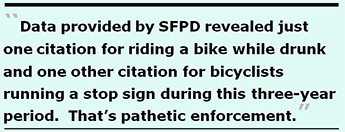 The data was generated
from SFGH’s Trauma Registry database, which captures information
about patients who suffered injuries that required hospitalization
or treatment in its ER, whether not they are admitted to the hospital.
The Trauma Registry includes patients with severe injuries, as
well as those with minor and even no injuries, those who required
admission, those who were discharged from the ER, and patients
who were not evaluated by the Trauma Team but required admission
to a surgical service (e.g., orthopedics, neurosurgery, etc.)
due to their injuries. The Trauma Registry only captures data
about the most severely injured, and does not include patients
who were not seen by
the Trauma Team but were seen in the ER, treated, and discharged.
The data was generated
from SFGH’s Trauma Registry database, which captures information
about patients who suffered injuries that required hospitalization
or treatment in its ER, whether not they are admitted to the hospital.
The Trauma Registry includes patients with severe injuries, as
well as those with minor and even no injuries, those who required
admission, those who were discharged from the ER, and patients
who were not evaluated by the Trauma Team but required admission
to a surgical service (e.g., orthopedics, neurosurgery, etc.)
due to their injuries. The Trauma Registry only captures data
about the most severely injured, and does not include patients
who were not seen by
the Trauma Team but were seen in the ER, treated, and discharged.
There are numerous hospitals in San Francisco; each receives some pedestrian injuries, but that data is obviously not captured by SFGH’s Trauma Registry, or easily or publicly available.
Data DPH provided for the five-year period between calendar years 2010 and 2014 showed:
Table 1: SFGH Trauma Registry by Type of Accident — Calendar Years 2010 to 2014
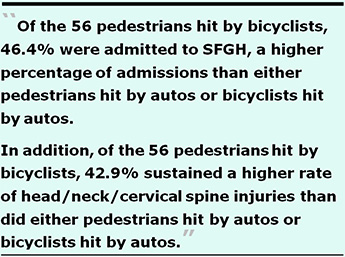

Clearly, pedestrians face the greatest risks between accidents with bikes and cars that comprise over two-thirds of all accidents, compared to cyclists. While the data showed a relatively small number of pedestrians — 56 — were struck by bicyclists and treated at SFGH, their outcomes were disproportionately severe:
Table 2: SFGH Trauma Registry Data Outcomes — Calendar Years 2010 to 2014

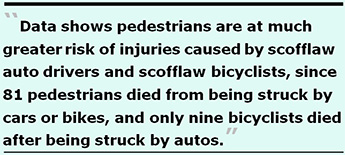 Of the 56 pedestrians
hit by bicyclists, 46.4% (26) were admitted to SFGH, a significantly
higher percentage of admissions than either pedestrians hit by
autos or bicyclists hit by autos.
Of the 56 pedestrians
hit by bicyclists, 46.4% (26) were admitted to SFGH, a significantly
higher percentage of admissions than either pedestrians hit by
autos or bicyclists hit by autos.
For its part, SFPD reported (Table 4, below) that there were 86 collisions between bicyclists and pedestrians between 2012 and September 30, 2015. The difference between DPH’s and SFPD’s data — 56 vs. 86 — may be due to whether the accidents involved transport to SFGH’s or to some other Bay Area hospital that admit injured pedestrians.
Of the 56 pedestrians hit by bicyclists, their two deaths reflected
a higher mortality rate than did either pedestrians hit by autos
or bicyclists hit by autos. That’s 56 pedestrians struck
by bicyclists too many, and two deaths too many.
Table 2 also shows that of the 56 pedestrians hit by bicyclists,
42.9% (24) sustained a higher rate of head/neck/cervical spine
injuries than did either pedestrians hit by autos (17 percent
lower) or bicyclists hit by autos (half as low, at 21.8%). Notably,
head/neck/cervical spine injuries were double the rate for pedestrians
stuck by bicyclists — whether or not cyclists were travelling
at six miles per hour or more — than for bicyclists struck
by autos.
 DPH also reported
that in the same five-year period, 1,307 bicyclists were hit by
automobiles, 24.3% (318) of whom were admitted to SFGH. Of cyclists
hit by autos, 21.8% (285) sustained head/neck/cervical spine injuries,
and nine died. Suhr noted on December 4 that another two bicyclists
died in 2015, bringing the total to 11 bicyclist deaths, which
is not yet recorded in DPH’s Trauma Registry as the data
for 2015 is not yet complete.
DPH also reported
that in the same five-year period, 1,307 bicyclists were hit by
automobiles, 24.3% (318) of whom were admitted to SFGH. Of cyclists
hit by autos, 21.8% (285) sustained head/neck/cervical spine injuries,
and nine died. Suhr noted on December 4 that another two bicyclists
died in 2015, bringing the total to 11 bicyclist deaths, which
is not yet recorded in DPH’s Trauma Registry as the data
for 2015 is not yet complete.
Of the 2,687 pedestrians struck by automobiles in the same period, 35.5% (953) were admitted to SFGH, 25.3% sustained head/neck/cervical spine injuries, and 79 died.
Of the 4,050 injuries reported by DPH involving pedestrians vs. bicyclists, pedestrians vs. autos, and bicyclists vs. autos in this five-year period, fully 67.7% (2,743) involved pedestrians going up against bikes and cars; the remaining 32.3% involved bicyclists going up against cars. Clearly, pedestrians are at much greater risk of injuries caused by scofflaw auto drivers and scofflaw bicyclists, since 81 pedestrians died from being struck by cars or bikes, and only nine bicyclists died after being struck by autos.
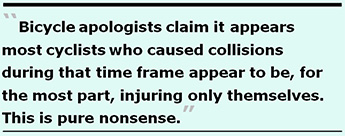
And that doesn’t count pedestrians killed by cyclists or autos and pronounced dead at the scene, and never transported to SFGH, or pedestrians transported to other hospitals.
There’s clearly a public health cost — along with patient trauma — from such injuries, which Ms. Breed must be aware is “important,” despite her protestations. Unfortunately, SFGH’s Trauma Registry doesn’t capture data on pedestrians injured by cyclists who were transported to private hospitals, so comprehensive data isn’t collected citywide. And SFGH’s Trauma Registry database obviously doesn’t capture fatalities who weren’t transported to SFGH, but to the Medical Examiner’s office or the City morgue, instead.
KQED reported on December 7, 2015 that bicycle apologists claim it appears most cyclists who caused collisions during that time frame appear to be, for the most part, injuring only themselves. This is pure nonsense.
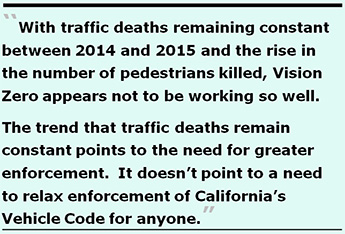 “Injuring just
themselves” — when SFPD data shows 86 pedestrians were
involved in collisions with bicyclists — appears to be bicycle
advocates just making stuff up to pamper their sense of entitlement,
notwithstanding clearly disproven by DPH’s and SFPD’s
data.
“Injuring just
themselves” — when SFPD data shows 86 pedestrians were
involved in collisions with bicyclists — appears to be bicycle
advocates just making stuff up to pamper their sense of entitlement,
notwithstanding clearly disproven by DPH’s and SFPD’s
data.
KQED reported that Andrew Stoltzfus, a bike coalition member, said he is deeply skeptical of numbers released by SFPD, considering SFPD’s troubling history of blaming bike riders in collisions. Well, Mr. Stolzfus, although Bicycle Coalition members may want to stick their collective heads in the sand, the 56 pedestrians hit by bicyclists, and the two dead pedestrians — documented by SFGH’s trauma data base, not SFPD — may well disagree that bicyclists are only injuring themselves “for the most part.”
The Vision Zero Coalition released a report in February 2015 reporting progress the City made during 2014, noting that 29 people were killed in traffic in 2014, including 17 pedestrians, 3 bicyclists, and 9 drivers. [Note: SFGH’s Trauma Registry database reported just 26 traffic deaths during 2014, the difference between the two data sources may be fatalities transported directly to the morgue who never made it to SFGH, or accident victims transported to other hospitals who died.]
Preliminary results reported by DPH through the end of November 2015 show another 29 people were killed in traffic in 2015, including the same number of 3 bicyclists, only 7 drivers, and 19 pedestrians — with another 30 days to go in December 2015.
The 17 pedestrians killed in 2014 represented 58.6% of all traffic deaths; the 19 pedestrians killed through November 2015 represent 65.5% of all traffic deaths, with 30 days to go. Clearly, with traffic deaths remaining constant between 2014 and 2015 and the rise in the number of pedestrians killed, Vision Zero appears not to be working so well, no matter what the Bicycle Coalition may want you to believe.
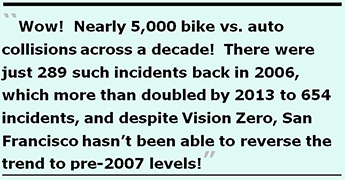 The trend that traffic
deaths remain constant points to the need for greater enforcement.
It doesn’t point to a need to relax enforcement of California’s
Vehicle Code for anyone.
The trend that traffic
deaths remain constant points to the need for greater enforcement.
It doesn’t point to a need to relax enforcement of California’s
Vehicle Code for anyone.
9–1–1 Dispatch Data
Another records request to San Francisco’s Department of Emergency Management revealed the 9–1–1 dispatch system received 3,479 calls between calendar year 2013 and December 21, 2015 regarding automobile vs. motorized/non-motorized two-wheeled vehicle accidents, 56.5 percent of which (1,964) involved patients transported to hospitals during the three-year period. Of those transported, 76 percent (1,485) were transported to San Francisco General Hospital, and the remainder transported to other Bay Area hospitals.
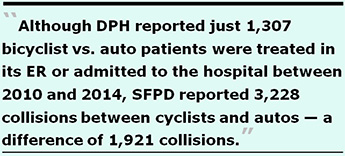 It should be
noted the national medical protocol used by San Francisco 9–1–1
dispatchers doesn’t differentiate the type of two-wheel vehicles
involved (bikes vs. motorcycles, scooters, etc.), so it’s
unclear how many of these accidents involved autos vs. bicyclists.
That said, the call volume clearly places an “important”
strain on 9–1–1 dispatchers, as Breed should know, and
impacts patient care at SFGH and other hospitals.
It should be
noted the national medical protocol used by San Francisco 9–1–1
dispatchers doesn’t differentiate the type of two-wheel vehicles
involved (bikes vs. motorcycles, scooters, etc.), so it’s
unclear how many of these accidents involved autos vs. bicyclists.
That said, the call volume clearly places an “important”
strain on 9–1–1 dispatchers, as Breed should know, and
impacts patient care at SFGH and other hospitals.
Concerning Police Department Records Responses
A records request to SFPD placed on December 14, 2015 revealed troubling data in its initial, flawed responses. After pressing SFPD for over a month for meaningful bicyclist data, by January it was clear SFPD’s data lacks veracity.
SFPD Collision Data
Table 3: Number of Collisions: Bicyclist vs. Automobile (BVA) — Calendar Years 2006 to 2015

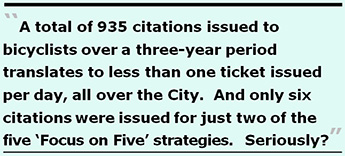 Wow! Nearly 5,000
bike vs. auto collisions across a decade! There were just 289
such incidents back in 2006, which more than doubled by 2013 to
654 incidents, and despite Vision Zero San Francisco hasn’t
been able to reverse the trend to pre-2007 levels!
Wow! Nearly 5,000
bike vs. auto collisions across a decade! There were just 289
such incidents back in 2006, which more than doubled by 2013 to
654 incidents, and despite Vision Zero San Francisco hasn’t
been able to reverse the trend to pre-2007 levels!
Although DPH reported just 1,307 bicyclist vs. auto patients were treated in its ER or admitted to the hospital between 2010 and 2014, SFPD reported 3,228 collisions between cyclists and autos during the same period — a difference of 1,921 collisions.
It’s unclear whether some of the other 1,921 incidents involved transport to hospitals other than SFGH; whether some of the incidents involved fatalities who were transported to the morgue, instead; or whether some of the incidents involved no need for transport for medical care to any hospital.
Table 4: Number of Collisions: Pedestrians vs. Bicyclists (PVB) — Calendar Years 2006 to 2015
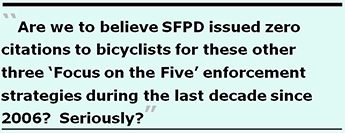
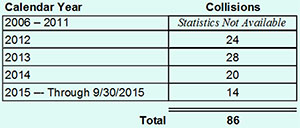
Although DPH’s data showed just 56 pedestrian vs. bicyclist incidents across the five-year period between 2010 and 2014, Table 4 above shows SFPD asserted there were 86 such incidents across just four years — with data for 2010 and 2011 ostensibly unavailable. This is worrisome, since if there were even just another 20 collisions each year in 2010 and 2011 unreported by SFPD, that portends another 40 collisions, pushing SFPD’s numbers to more like 126 collisions, not the 56 reported by DPH or the 86 reported by SFPD.
SFPD Bicyclist Citations Data
As troubling as SFPD’s collision data are, the dismal enforcement with citations issued by SFPD is more troubling.
Table 5: Stratification of Citations Issued to Bicyclists — Calendar Years 2006 to 2015

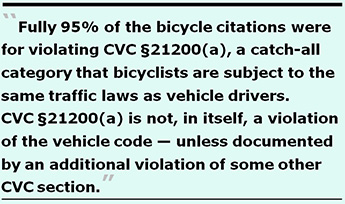 A
total of 935 citations issued to bicyclists over a three-year
period translates to less than one ticket issued per day, all
over the City. Seriously?
A
total of 935 citations issued to bicyclists over a three-year
period translates to less than one ticket issued per day, all
over the City. Seriously?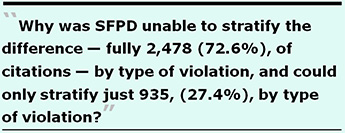 Of note, CVC §21200(a)
is not, in itself, a violation of the vehicle code — unless
it is documented by an additional violation of some other section
of the vehicle code. CVC §21200(a) is simply an identifier
that another vehicle code section violation was committed by
a bicyclist, rather than committed by a motor vehicle driver.
Since it is simply an identifier, no specific fine amount is
listed in California’s Uniform Bail and Penalty Schedule.
Of note, CVC §21200(a)
is not, in itself, a violation of the vehicle code — unless
it is documented by an additional violation of some other section
of the vehicle code. CVC §21200(a) is simply an identifier
that another vehicle code section violation was committed by
a bicyclist, rather than committed by a motor vehicle driver.
Since it is simply an identifier, no specific fine amount is
listed in California’s Uniform Bail and Penalty Schedule.Table 6: Citations Issued to Bicyclists by Police Station — Calendar Years 2006 – September 2015

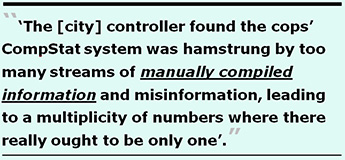 Of great concern
is why SFPD stratified by type of violations just 935 citations
issued to bicyclists between 2006 and 2015 in Table 5, but data
SFPD presented in Table 6 above shows fully 3,413 citations issued
during the same period. Why was SFPD unable to stratify the difference
— fully 2,478, or 72.6%, of citations — by type of
violation, and stratified just 935, or 27.4%, by type of violation?
Of great concern
is why SFPD stratified by type of violations just 935 citations
issued to bicyclists between 2006 and 2015 in Table 5, but data
SFPD presented in Table 6 above shows fully 3,413 citations issued
during the same period. Why was SFPD unable to stratify the difference
— fully 2,478, or 72.6%, of citations — by type of
violation, and stratified just 935, or 27.4%, by type of violation?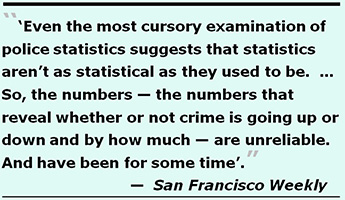 More sadly, it appears
that the number of citations issued is not correlated to the greater
number of collisions reported by DPH and the Police Department.
More sadly, it appears
that the number of citations issued is not correlated to the greater
number of collisions reported by DPH and the Police Department.
“Seven Ate Nine”: SFPD’s Unreliable Crime Stats
After receiving SFPD’s initial responses for bicyclist citation data, several follow-up records requests seeking clarification further exposed SFPD’s flawed record keeping.
As Joe Eskenazi noted in his December 2014 article in the San Francisco Weekly, titled “Seven Ate Nine: The San Francisco Police Department’s Crime Stats Aren’t What They Used to Be,” SFPD has a troubled history of fudging its crime stats. Eskenazi reported, in part:
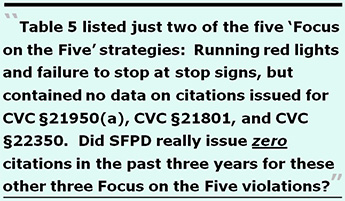 Now, SFPD’s
misinformation about crime stats appears to be mirrored in traffic
citation statistics SFPD issued not only to motorists, but also
to bicyclists.
Now, SFPD’s
misinformation about crime stats appears to be mirrored in traffic
citation statistics SFPD issued not only to motorists, but also
to bicyclists.
SFPD initially reported for this article that between calendar years 2013 and 2015, the ten District Police Stations and the Traffic Company had issued a total of 3,413 citations shown in Table 6 above. However, the first table SFPD provided (Table 5 above) breaking down the number of citations issued by type violation of the CVC totaled just 935 citations, a difference of 2,478 citations, leading to several questions:
 Table 5 that SFPD
provided listed a total of 887 citations issued to bicyclists
— fully 94.9% of the 935 citations listed in the table —
as having been issued for violating CVC § 21200(a) (Bicyclists
subject to same laws as drivers). Did those 887 citations issued
for violating §21200(a) not record the actual violation
that occurred, or did SFPD not retain the multiple citations
issued on those tickets?
Table 5 that SFPD
provided listed a total of 887 citations issued to bicyclists
— fully 94.9% of the 935 citations listed in the table —
as having been issued for violating CVC § 21200(a) (Bicyclists
subject to same laws as drivers). Did those 887 citations issued
for violating §21200(a) not record the actual violation
that occurred, or did SFPD not retain the multiple citations
issued on those tickets?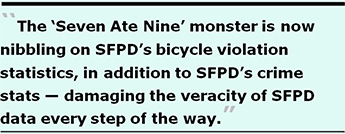 Pressing SFPD’s
public information staff further revealed that only the Traffic
Company may have more precise and accurate data, since they issue
electronically-issued citations and may retain the electronic
data. On January 8, 2016 SFPD provided updated records showing
the types of citations issued, but the new information was disappointing.
Pressing SFPD’s
public information staff further revealed that only the Traffic
Company may have more precise and accurate data, since they issue
electronically-issued citations and may retain the electronic
data. On January 8, 2016 SFPD provided updated records showing
the types of citations issued, but the new information was disappointing.
SFPD included citations issued in the last three months of 2015, as Table 7 shows. Notably, nearly half — 47.8% — of the additional 253 tickets issued during the fourth quarter were issued by the Tenderloin District and Mission District police stations, and an additional 10% were issued citywide by the Traffic Company.
Table 7: Citations Issued to Bicyclists by Police Station
— Fourth Quarter 2015

 Table 8 below revises
Table 6, to include the additional citations issued between October
and December 2015.
Table 8 below revises
Table 6, to include the additional citations issued between October
and December 2015.
While the Bicycle Coalition has complained bitterly about an up-tick in the number of citations issued by Captain Sanford’s officers in the Park Station, the Richmond District actually saw the highest percent change from 2014 to 2015, with a 244.2% increase in the number of citations issued. Five of the Police Districts and the Traffic Division saw increased citation enforcement in 2015, while the other five Police Districts experienced fewer bicycle citations issued.
Disturbingly, bike enforcement appears to be down by nearly 60% by SFPD staff at both the Southern and Bayview district stations, not a good outcome for pedestrians. Citations increased a modest 2.5% citywide across the two years.
Table 8: Citations Issued to Bicyclists by Police Station — 2006 – 2015

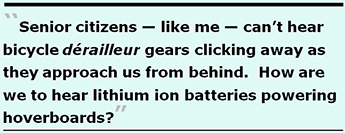 But a disappointing
January 8 records update from SFPD did not include further stratification
about the types of citations issued. Instead, SFPD claimed that
although the bicycle citations issued by the Traffic Company —
which are issued using electronic handheld devices — were
thought to be capable of generating a breakout of the type of
citations issued, details about the citations were apparently
unavailable. SFPD noted:
But a disappointing
January 8 records update from SFPD did not include further stratification
about the types of citations issued. Instead, SFPD claimed that
although the bicycle citations issued by the Traffic Company —
which are issued using electronic handheld devices — were
thought to be capable of generating a breakout of the type of
citations issued, details about the citations were apparently
unavailable. SFPD noted:
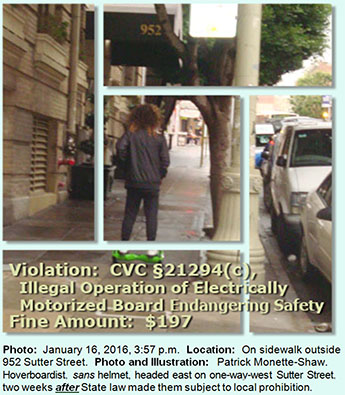 It seems
inconceivable that the handheld electronic devices are apparently
capable of printing out paper citations to hand to bicyclists
listing each violation that may have occurred in addition to CVC
§21200(a) [which is just an identifier that a vehicle code
violation was committed by a bicyclist], but then any pre-programmed
reports stored on the devices are only capable of printing just
the first citation issued — in this case the identifier showing
the citation was issued to a bicyclist.
It seems
inconceivable that the handheld electronic devices are apparently
capable of printing out paper citations to hand to bicyclists
listing each violation that may have occurred in addition to CVC
§21200(a) [which is just an identifier that a vehicle code
violation was committed by a bicyclist], but then any pre-programmed
reports stored on the devices are only capable of printing just
the first citation issued — in this case the identifier showing
the citation was issued to a bicyclist.
What good are the handheld devices if they would have to print out all 1,613 citations issued in 2015 and then have to manually count each type of violation issued? Is this because SFPD does not have I.T. staff with the expertise to know how to access the additional citation data stored on the devices and tabulate the results electronically rather than by hand? Are we back to the City Controller’s concern in 2012 that SFPD has too many streams manually-compiled statistics?
The update did indicate that the number of citations for violating CVC §22450(a) — prohibiting running stop signs — between January and November 2015 grew from one just citation across the entire City, to three citations. Really? Just three citations for running stop signs fueled the Bicycle Coalition’s drama and angst?
SFPD also reported in its update that there were still zero citations issued to bicyclists for Failure to Yield to Pedestrians [presumably violating pedestrian right-of-way (CVC §21950(a)]. SFPD noted there were no additional citations issued between October and December 2015 to bicyclists riding on sidewalks in violation of San Francisco Transportation code 7.2.12, which remained at a total of eight citywide during all of 2015.
Sadly, the January 8 update illustrated the “Seven Ate Nine” phenomena, since SFPD reported there were only 405 citations issued for CVC §21200(a) — the identifier code, for bicyclists subject to same laws as drivers — a reduction from 408 citations SFPD first reported for this article.
So the “Seven Ate Nine” monster is now nibbling on SFPD’s bicycle violation statistics, in addition to SFPD’s crime stats — damaging the veracity of SFPD data every step of the way. It’s unacceptable that the Vision Zero campaign has to rely on unreliable SFPD data involving bicyclist citations and resulting pedestrian injuries.
After all, in the absence of stratifying the volume of citations issued by the particular violation infraction committed, how can there be targeted enforcement or targeted education campaigns to change cyclists’ behavior if City officials don’t know which sections of the vehicle code bicyclists are violating?
Another Looming Pedestrian Risk: Hoverboards
 The San Francisco
Weekly published an article by its managing editor, Jeremy Lybarger,
on December 24, 2015 regarding whether hoverboards — particularly
self-balancing scooters powered by lithium ion batteries that
have a nasty habit of exploding and are banned on airlines —
will be subject to San Francisco’s “rolling stop”
bicycle legislation.
The San Francisco
Weekly published an article by its managing editor, Jeremy Lybarger,
on December 24, 2015 regarding whether hoverboards — particularly
self-balancing scooters powered by lithium ion batteries that
have a nasty habit of exploding and are banned on airlines —
will be subject to San Francisco’s “rolling stop”
bicycle legislation.
Lybarger reported there was then some debate among San Francisco city officials and City departments about whether hoverboards were “subject to the same rules of the road as bicycles, motorized skateboards, and other wheeled devices.”
Hoverboards are misnamed, as they don’t actually hover above the ground on a cushion of air. And they travel at speeds of up to 12 miles-per-hour, twice the speed of the six miles-per-hour being considered for the bicycle rolling-stop legislation. Any vehicle going 12 miles-per-hour can inflect severe injuries in accidents involving pedestrians.
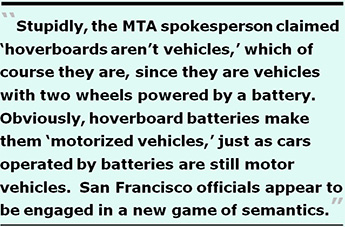 Senior citizens —
like me — who have had life-long hearing impairments since
birth all too frequently can’t hear bicycle dérailleur
gears clicking away as they approach us from behind. How are we
— senior citizens and I, and everyone else — supposed
to hear lithium ion batteries powering hoverboards? Do the batteries
make some sort of sound audible to human ears?
Senior citizens —
like me — who have had life-long hearing impairments since
birth all too frequently can’t hear bicycle dérailleur
gears clicking away as they approach us from behind. How are we
— senior citizens and I, and everyone else — supposed
to hear lithium ion batteries powering hoverboards? Do the batteries
make some sort of sound audible to human ears?
How can it be that the San Francisco Board of Supervisors, SFMTA, and the Police Department were unable to reach consensus in determining whether hoverboards are motorized vehicles, when New York City’s Police Department had outlawed them on both sidewalks and New York streets? Can’t our “consensus Mayor” Ed Lee help broker this?
Supervisor John Avalos declined to comment to the Weekly, Supervisor Eric Mar said he had no idea, and Supervisor Mark Farrell claimed the legislation only applies to bicyclists, not people riding hoverboards. Lybarger reported that an SFMTA spokesperson wasn’t able to clarify the issue. Stupidly, the MTA spokesperson claimed “hoverboards aren’t vehicles,” which of course they are, since they are vehicles with two wheels powered by a battery.
According to the medical protocol employed by 9–1–1 dispatchers at San Francisco’s Department of Emergency Management, other two-wheeled devices are classified as vehicles, whether motorized or not. Why would SFMTA believe that two-wheeled hoverboards might be classified differently?
In response to a records request, SFMTA declined providing
the name of its spokesperson who spoke with Lybarger, secrecy
trumping accountability from government officials.
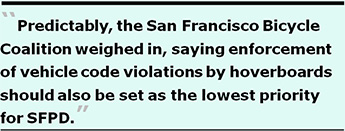 This is nonsense.
Obviously, hoverboard batteries make them “motorized vehicles,”
just as cars operated by batteries are still motor vehicles! San
Francisco officials appeared to be engaged in a new game of semantics.
This isn’t rocket science.
This is nonsense.
Obviously, hoverboard batteries make them “motorized vehicles,”
just as cars operated by batteries are still motor vehicles! San
Francisco officials appeared to be engaged in a new game of semantics.
This isn’t rocket science.
Even more ridiculously, although New York City police have declared hoverboards illegal on both streets and sidewalks and subject to a $200 fine, Commander Ann Mannix in San Francisco’s Police Department claimed further research was required about whether the hoverboards are subject to traffic laws, suggesting it may be contingent on how egregious a hoverboard-caused violation causing an accident is. Mannix, a job classification 0490 Commander III, was paid $226,497 in total pay in the fiscal year ending June 30, 2015 — perhaps for her skills using spin control. This should not rely on whether an event was “egregious,” it should rely on whether behaviors are clearly illegal.
Predictably, the San Francisco Bicycle Coalition weighed in, saying enforcement of vehicle code violations by hoverboards should also be set as the lowest priority for SFPD, claiming that since the majority of traffic injuries and deaths are caused by autos, any accidents caused by non-majority bicyclists and people riding hoverboards should have an exemption carved out for them.
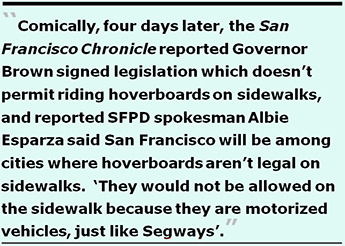 It shouldn’t
take SFGH’s trauma unit, 9–1–1 emergency dispatchers,
and SFPD long to begin collecting statistics whether pedestrians
are, in fact, placed in harm’s way by hoverboards clogging
our sidewalks — along with scofflaw cyclists — but only
if they update their protocols to actually start collecting this
key data, accompanied by the political will to require
the data collection!
It shouldn’t
take SFGH’s trauma unit, 9–1–1 emergency dispatchers,
and SFPD long to begin collecting statistics whether pedestrians
are, in fact, placed in harm’s way by hoverboards clogging
our sidewalks — along with scofflaw cyclists — but only
if they update their protocols to actually start collecting this
key data, accompanied by the political will to require
the data collection!
Comically, just four days after the Weekly published Lybarger’s article, on December 28 the San Francisco Chronicle reported Governor Jerry Brown signed legislation authored by Assemblywoman Kristin Olsen, R-Modesto, amending California’s vehicle code to permit hoverboards for 16-year-olds or older beginning on January 1, 2016 on streets, and in bike lanes and on bike paths, but only if riders wear a helmet. The legislation doesn’t address prohibiting riding hoverboards on sidewalks, since sidewalks fall under the jurisdiction of local cities, not California’s vehicle code. Each jurisdiction will decide whether to allow hoverboards on local sidewalks.
The Chronicle’s December 28 article reported SFPD spokesman Officer Albie Esparza — who “only” earned $148,166 in total pay during FY 14–15 compared to Commander Mannix’s $226,497 — luckily came to her aid. Esparza said San Francisco will be among cities where hoverboards aren’t legal on sidewalks. “They would not be allowed on the sidewalk because they are motorized vehicles, just like Segways,” Esparza said. As if Ms. Mannix couldn’t discern this, herself.
What’s next? Will both hoverboardists and auto drivers demanding they are “entitled” to a rolling-stop exemption privilege, too? And will San Francisco’s Board of Supervisors cave in to another bloc of “entitled” voters?
Nonsense From City Supervisors
The San Francisco Examiner reported December 16, 2015 that Supervisor Avalos is concerned that scofflaw cyclists can’t afford to be ticketed. “Ticketing for biking cautiously through a stop sign is $200. For many people, that’s the difference between making their monthly rent or not,” Avalos whined.
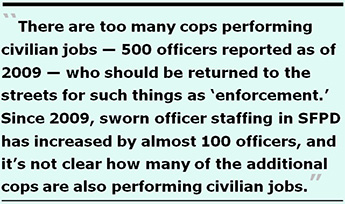 Examiner reader
Joe Mac published a letter-to-the-editor on December 23, in which
Mr. Mac noted that kind of logic left him
shaking his head. Mr. Mac offered a suggestion: “Don’t
run through the damn stop sign and you can make your rent.”
Amen, Mr. Mac!
Examiner reader
Joe Mac published a letter-to-the-editor on December 23, in which
Mr. Mac noted that kind of logic left him
shaking his head. Mr. Mac offered a suggestion: “Don’t
run through the damn stop sign and you can make your rent.”
Amen, Mr. Mac!
I have an idea: Prominently post bicycle traffic fine amounts on SFPD’s and the Bicycle Coalition’s web site so bicyclist’s will know beforehand the corresponding fines they may face for flagrant violations of California’s vehicle code. Perhaps then, they’ll be able to calculate in advance whether they will be able to make their rent payments after having to pay any traffic fines they incur, or whether any momentary “inconveniences” by obeying various traffic laws is worth the price of getting fined. If it’s “inconvenient” for them to obey the law, fine the hell out of them, inability to pay rent concerns be damned!
That’s more likely to help with “enforcement,” lessening any burden on police officers to assess whether the violations are the “least important” of their duties. Problem solved! Educating bicyclists in advance may deter their scofflaw behavior. It would be as simple as posting a table of the fines, like this:
Table 9: California Judicial Council Uniform Bail and Penalty Schedules, 2015 Edition: Bicycle Fine Amount Extract
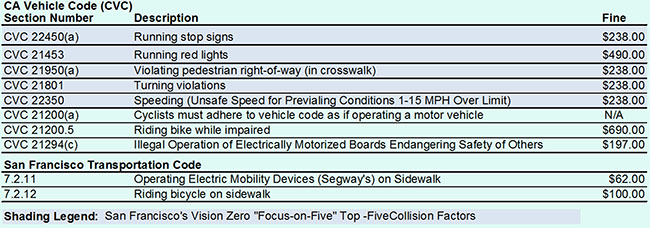
 Source:
Uniform
Bail and Penalty Schedule — 2015 Edition, link provided
by SFPD.
Source:
Uniform
Bail and Penalty Schedule — 2015 Edition, link provided
by SFPD.
Board of Supervisors Ignores SFPD Staffing Problems
The Examiner reported December 16 that for his part, Supervisor Wiener, who supports rolling stops said, “We have far better uses for our scarce law enforcement resources.” Really, Supervisor Wiener? Or are you and Supervisor London “Limited Police Resources Should Be Used for More Important Things” Breed conveniently reading from the same playbook?
 After all, BeyondChron
reported former Mayor Gavin Newsom eliminated
264.66 unfilled civilian positions at SFPD in 2009 in a cost-savings
budget reduction. The fact is, there were too many cops performing
civilian jobs — 500 officers as BeyondChron reported
as of 2009, including 148 police officers, sergeants, and lieutenants
in SFPD Administration, now probably higher — who should
be returned to the streets for such things as “enforcement.”
Had those civilian positions been retained, they could free up
scare sworn police officer resources that Mr. Wiener and Ms. Breed
whine about.
After all, BeyondChron
reported former Mayor Gavin Newsom eliminated
264.66 unfilled civilian positions at SFPD in 2009 in a cost-savings
budget reduction. The fact is, there were too many cops performing
civilian jobs — 500 officers as BeyondChron reported
as of 2009, including 148 police officers, sergeants, and lieutenants
in SFPD Administration, now probably higher — who should
be returned to the streets for such things as “enforcement.”
Had those civilian positions been retained, they could free up
scare sworn police officer resources that Mr. Wiener and Ms. Breed
whine about.
Since 2009, sworn officer staffing in SFPD has increased by almost 100 officers since Mayor Lee and Chief Suhr took office during FY 2010–2011, but it’s not clear how many of the additional cops are also performing civilian jobs.
Table 10: Changes in SFPD Sworn Officer Staffing — FY 2010–2011 vs. FY 2014–15
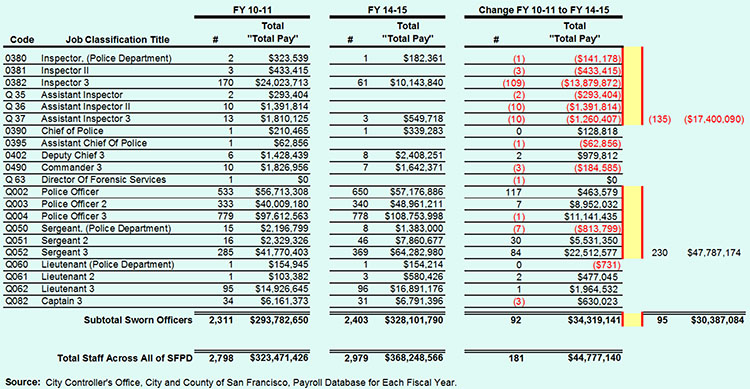
 In March 2011 San
Francisco Public Defender Jeff Adachi released surveillance videos
from the Henry Hotel that revealed San Francisco Police Department
narcotics officers had falsified police reports in order to justify
searching residences without warrants or consent. The three plainclothes
cops were subsequently indicted along with two other officers.
All five (or more) had engaged in “multiple criminal conspiracies.”
In March 2011 San
Francisco Public Defender Jeff Adachi released surveillance videos
from the Henry Hotel that revealed San Francisco Police Department
narcotics officers had falsified police reports in order to justify
searching residences without warrants or consent. The three plainclothes
cops were subsequently indicted along with two other officers.
All five (or more) had engaged in “multiple criminal conspiracies.”
In a potential overreaction to Adachi’s release of the surveillance video’s, it is thought Chief Greg Suhr eliminated the Narcotics unit and phased out plain clothes officers. Then around 2010, SFPD reportedly held a final Inspector’s examination, before subsequently eliminating the job classification. As Table 10 shows above, that led to a decline of 135 Inspectors, when many inspectors retired and weren’t replaced.
In 2013 there was reportedly a mass exodus of Sergeants who had that stayed on for an additional year under the DROP program. Another examination test was held and at least 114 Sergeants were hired or promoted.
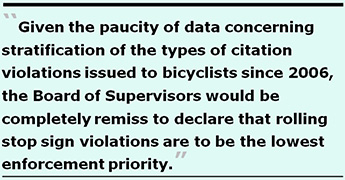 The Deferred Retirement
Option Program, or DROP — cooked up by former Police Officer
Association president Gary Delagnes — allowed cops over 50
years old with at least 25 years’ experience to begin collecting
pension benefits in addition to regular pay. Before DROP closed
enrollment in 2011, 341 police officers had enrolled. As of August
2013, DROP had cost San Francisco $58 million and there were still
73 officers enrolled in DROP, which was finally abandoned in 2014.
The Deferred Retirement
Option Program, or DROP — cooked up by former Police Officer
Association president Gary Delagnes — allowed cops over 50
years old with at least 25 years’ experience to begin collecting
pension benefits in addition to regular pay. Before DROP closed
enrollment in 2011, 341 police officers had enrolled. As of August
2013, DROP had cost San Francisco $58 million and there were still
73 officers enrolled in DROP, which was finally abandoned in 2014.
Since 2011, when Lee became Mayor and Suhr became Police Chief, there are now 135 fewer Inspectors, but an additional 230 Police Officers and Sergeants, for a net increase of 92 sworn officers costing $34.3 million more annually in total pay alone (including overtime pay and “other” pay) but excluding fringe benefits and retirement, which represented 77% of the $44.8 million increase in total pay for the Department’s increase of 181 additional employees.
It’s not clear how many of the 92 additional officers are also performing civilian jobs, but neither Supervisor Breed nor Supervisor Wiener appear too concerned about whether San Francisco has far better uses for our scarce law enforcement resources.
For that matter, if San Francisco is experiencing scarce law enforcement resources, why does the SFPD have at least seven sworn officers manning its two public information staffs, one for general members of the public and another in its Media Relations Unit? Based on payroll data obtained from the City Controller’s office, these seven officers earned over a million dollars in total pay alone (excluding fringe benefits and pensions) during the Fiscal Year ending June 30, 2015.
Table 11: Staffing of SFPD’s Public Information Department

If these seven public information officer jobs were civilianized, San Francisco could redeploy these seven sworn officers to enhance enforcement of “Focus on the Five” citations and otherwise beef up “scare enforcement resources,” as both Supervisors Breed and Wiener must know.
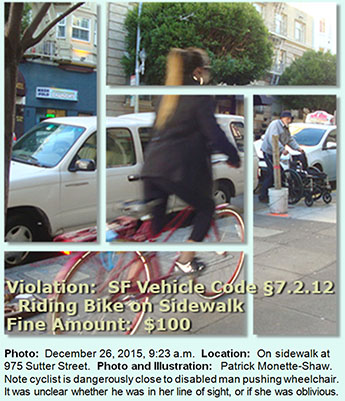 Don’t
you and Ms. Breed agree, Mr. Wiener, that these resources should
be converted to civilian positions, freeing these sworn officers
up to go out and join enforcement teams to protect both pedestrians
and cyclists?
Don’t
you and Ms. Breed agree, Mr. Wiener, that these resources should
be converted to civilian positions, freeing these sworn officers
up to go out and join enforcement teams to protect both pedestrians
and cyclists?
An Inconvenient Truty: Risks of “Rolling Stops”
It’s clear that the data show pedestrians are at great risk in San Francisco, from both bicyclists and motor vehicles. Passing the proposed “rolling stop” bicyclist ordinance may have an unintended consequence of not only encouraging illegal behavior by those using one specific mode of transportation — bicycles — but may also encourage auto drivers to engage in the same illegal behavior, since they also may feel as “entitled” to violate the top-five collision factors as their bicyclist brethren.
Has everyone forgotten that when laws are enforced, they’ll be obeyed, and when they aren’t enforced, they won’t be? Have cyclists concluded that given San Francisco’s totally inadequate enforcement, they can disobey the law with brazen impunity?
Apparently, millennial Sostek believes enforcement isn’t worthwhile and she shouldn’t have been singled out for having chosen to disobey the law. Chief Suhr disagreed when he noted it isn’t acceptable to encourage folks (like Ms. Sostek) to break a law that can result in injury or death simply because it is “inconvenient” for bicyclist’s to come to a complete stop. My life, safety, and eventual death shouldn’t hinge on whether Sostek and others are momentarily inconvenienced.
Given the paucity of data concerning stratification of the types of citation violations issued to bicyclists since 2006, the Board of Supervisors would be completely remiss to declare that rolling stop sign violations are to be the lowest enforcement priority. How could the Board of Supervisors adopt this legislation in the face of no data about the types of moving-violation offenses being committed by bicyclists?
Hopefully, Mayor Lee will veto this rolling-stop bicycle legislation, if it’s passed. My life — obviously worthwhile to me, if not to Ms. Sostek — may depend on his veto.
After all, I don’t want to become a “casualty” statistic in the on-going war of bicyclist “rights” resulting in pedestrian’s becoming collateral damage from friendly-fire, but truth-denying, bicyclists.
The truth — and I — don’t want to become a casualty in this ugly war on our commons, and on our common passageways.
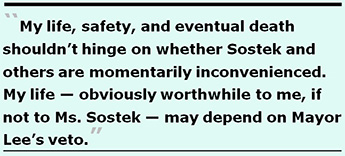 Monette-Shaw is an
open-government accountability advocate, a patient advocate, and
a member of California’s First Amendment Coalition. He received
a James Madison Freedom of Information Award from the Society
of Professional Journalists-Northern California Chapter in 2012.
He can be contacted at monette-shaw@westsideobserver.
Monette-Shaw is an
open-government accountability advocate, a patient advocate, and
a member of California’s First Amendment Coalition. He received
a James Madison Freedom of Information Award from the Society
of Professional Journalists-Northern California Chapter in 2012.
He can be contacted at monette-shaw@westsideobserver.
Postsrcipt
This article was completed and submitted to the Board of Supervisors prior to its January 12 hearing in the hope data from SFGH’s Trauma Registry, Department of Emergency Management’s 9–1–1 dispatch records, and SFPD citation and collision data might influence the Board to reject passing the Idaho “Rolling Stop” bicycle legislation on second reading.
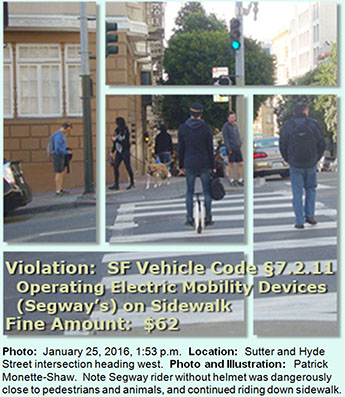 In an
apparent game of “chicken” with the Mayor, just six
members of the Board of Supervisors voted on second reading on
January 12 to ignore the Mayor’s warning and passed the rolling
stop Ordinance, ignoring endangered pedestrians in favor of “convenience”
— or “inconvenience“ — to a small, but very
politically vocal and loud group of bicyclists.
In an
apparent game of “chicken” with the Mayor, just six
members of the Board of Supervisors voted on second reading on
January 12 to ignore the Mayor’s warning and passed the rolling
stop Ordinance, ignoring endangered pedestrians in favor of “convenience”
— or “inconvenience“ — to a small, but very
politically vocal and loud group of bicyclists.
The Board ended up passing the Rolling Stop Bike Ordinance on second reading with Supervisors London Breed, John Avalos, David Campos, Jane Kim, Eric Mar, and Scott Wiener voting in favor, and Supervisors Mark Farrell, Aaron Peskin, Katy Tang, and Norman Yee voting against. Supervisor Malia Cohen was absent, excused due to travel; however, she had voted against passage of the Ordinance on its first reading on December 15.
The Mayor had ten calendar days from January 12 to decide whether to veto the Ordinance.
It appears the six City Supervisors who voted on January 12 to approve the legislation completely underestimated the Mayor’s resolve, perhaps pandering to the Bicycle Coalition’s most ardent members and their unending sense of entitlement to violate State law.
On September 28, 2015, Mayor Lee had communicated his opposition to the “Idaho Stop” legislation, warning the Supervisors of his intent to veto it, if it reached his desk. The Mayor wrote last September, in part:
On January 19, Mayor Lee carried through, and issued his veto, saying, in part:
The Board of Supervisors now have 30 days from the Mayor’s veto to override it, apparently on a calendar-day basis, suggesting that the Board of Supervisors has until February 18 to see if it can muster the eight votes necessary to override the Mayor’s veto.
It appears unlikely the Board of Supervsiors has the necessary eight votes needed to overturn the Mayor’s veto; it is thought that the Board is at least two votes short of being able to override the veto.
Contact the Board of Supervisors as soon as possible and urge them to reject any attempt to override the Mayor’s veto. Your life — and pedestrian safety — may depend on it.